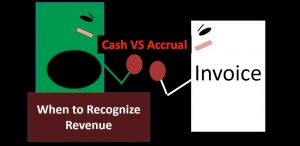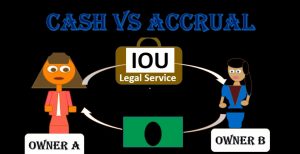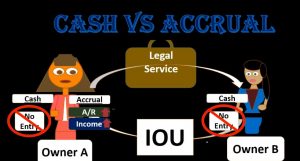Whoa in this presentation we will be discussing a cash method versus an accrual method objectives. We will be able to at the end of this, define and explain a cash method, define and explain an accrual method and explain the difference between the cash and accrual methods. When considering the cash method and the accrual method, they’re not necessarily completely different or diametrically opposed. But when presented, they are often presented in this format partially because in order to explain one, it’s often useful to know the other it’s useful to be able to compare the differences between the two methods.
00:42
But it’s also useful to understand where they are similar and where the two methods have similarities and things in common, such as when would the two methods result in revenue and expense recognition that would happen at the same point in time and look at why that would be case, when considering a cash versus accrual methods, we’re talking about timing differences. When considering timing differences. Were set, we’re talking about the timing financial statement, which is the income statement. So remember that the balance sheet represents the point in time where the company stands as of a point in time.
01:20
And the income statement is going to represent the time frame meaning how did the company do over time? The cash method versus the accrual method has completely to do with the timing statements meaning, when should we recognize revenue? At what point in time should revenue be recognized? And when should expenses be recognized? At what point in time should expenses be recognized? We can think about this kind of idea in terms of what should be the factor that we are looking for, for us to know when to recognize revenue. When considering that or when asked that question. Most of the time, many of us would say that right? Revenue should be recognized when cash is received. But that’s not necessarily the case. And because revenue and cash are often happening at the same point in time, as well as because of the fact that cash is the most common form of payment, we tend to equivocate the two things meaning we tend to think that revenue is cash. And that’s not the same thing.
02:22
Cash is not revenue. revenue is not cash. Revenue represents what has been earned. Cash represents one form of payment. A couple of ways to think about that we could we could recognize the fact that we can get paid in some other way while still earning revenue, if we did work, earned revenue, and received a barter system, some other sort of form of compensation in terms of services, or a car or something like that. Health insurance benefits. Those are other forms of payment that we can receive while earning revenue. Notice that when we record revenue, just like we’re when we record Anything on the financial statements whether they be assets, liabilities, equity, income or expense, we’re going to measure those things in terms of dollars dollars being like a measuring tool. But that doesn’t mean that the revenue equals the dollars the dollars represent how we’re measuring how much revenue has been earned a unit a unit of measure when considering in that case, it’s also true that expenses are not equivalent to cash.
03:28
This is not as common has to be seen that expenses are equivalent to cash or for people to think that expenses are equivalent to cash as they think revenue as we tend to think revenue is equivalent to cash, but it does happen that we start to equivocate what expenses are and cash are meaning. If we were to ask the question, when should we recognize the expense? We often think when cash is paid. For example, when should we recognize the phone bill or the phone expense? How about when cash is paid, and oftentimes those two things happen at the same point in time.
04:00
But cash really shouldn’t be the driving factor cash is going to be the indication of when the expense happened. So then what’s the question then is when should we be recognizing revenue? When should we be recognizing an expense? And the answer is when they have been incurred. So when they have been incurred when we earned the revenue, meaning when the job has been done, and when we incurred the expense, meaning when we consumed an asset or incurred a liability in order to help us to generate revenue in the same time period. The reason those two things are a little bit differently expensive sounding a bit more complicated, is that our goal, of course, in the business is revenue generation. So when we think about revenue, when when do we recognize revenue? When we do what the business does in order to generate revenue, that’s what the business is in business to do.
04:49
The expenses are things that we had to expend in order to achieve the goal. So when are we going to recognize an expense when we had consumed something an asset we had to use it up or incur a liability, we’re going to use a resource in the future that we had to consume at this point in time, in order to help us achieve the goal of revenue generation. We can think about this in terms of a couple transactions. And it’s useful to think of a transaction and know that the transaction has two sides to it, meaning we’ve got owner a here who is is going to sell pizza and receive cash. And we can think about the the second transaction being the purchase of the pizza is also an owner, that’s purchasing the pizza possibly for a meeting or something like that and paying cash. every transaction every every revenue to one side is going to be an expense to somebody else. All expenses to one person or business is revenue to another person, person or business.
05:44
It’s often useful to think about these concepts in relation to both sides of the transaction. If we think about the cash versus accrual method, we can think of this transaction happening for Person A the company that is selling the pizza and receiving the cash Cash method, we would have cash increasing because cash has been received. And we would have income increasing because cash has been received. And that means that we’re recognizing revenue or income. At the point in time cash is received cash been an indication of when the revenue should be recognized meaning we’re using cash as kind of a flag to tell us when revenue should be recognized because the work had been earned.
06:28
So because cash has been received close enough, we’re saying cash method cash has been received close enough to the point in time that we do the work that we’re just going to use this as the triggering factor to record revenue. On the accrual side on the accrual side we would have the same transaction we would still be increasing cash because we had received cash and we would still be increasing revenue. However, the reason has been different here we have a different reason for why income is going up we have the exact same transaction The exact same two accounts happening under both a cash method and an accrual method. So the two methods resulting in the same transaction, but for different reasons. The cash method, we’re recording the revenue because we receive cash and that is the triggering factor.
07:16
Under the accrual method, we’re recording revenue because we did the work. So under the accrual method of fact that we delivered the pizza in this case, that is the thing that is driving us to record revenue under the accrual method. If we’re the owner, be here and we are the person person purchasing the pizza and paying cash, then under a cash method, cash would go down, cash is being paid, and expenses would go up. So now we’re going to increase the expenses and decrease the cash under a cash method. under an accrual method, we would still be decreasing cash because cash is still going down, and we would still be increasing the expense, but for different reasons. Remember that the cash Here is an indication, in this case of when the expense has been incurred, meaning we have a cash system saying, we are going to recognize an expense when cash is leaving the company, not necessarily because cash is equivalent to an expense.
08:14
But because it’s usually close enough in time. For us to use that method. It’s an easy method for us to use. It’s kind of a shortcut method for us to use. If we want to be more accurate, we would use the accrual method and say that this cash is not the thing that’s going to trigger or drive the transaction, but it’s going to be the receipt of the service. In this case, the receipt the consumption of the pizza in this case, would be the expense for meals and entertainment that drives the transaction. So this case is the case where both methods result in the same transaction. And when we see a method like this, when we see a company that sells pizza, for example, if they were to receive cash only at the point of sale, they may consider themselves On an on a cash method, simply because they have a policy of only recording services for the receipt of cash.
09:09
But note that that’s not necessarily what a cash method is. That’s just a policy that the that the owner has may or may it may be a good policy to have has nothing to do with a cash versus accrual method, we could still be in an accrual method and use that policy. This this method right here, even though it uses the same transaction could be on an accrual or cash method. It just so happens that the format of the transactions result in the same outcome, the same journal entries under the revenue recognition principles. If we look at a different transaction, bit more interesting transaction in terms of analyzing the differences between a cash method an accrual method, we’re going to take and differentiate when cash is received to when the service is done. In this case, we have a law firm doing services and they have not yet done the services they’re going to they’re going to get retainer or a deposit.
10:02
So they’re going to get money before they do the work in order to ensure that payment will be received. So money is being received by the law firm, and work will then be done in the future. For Company B, of course, money is being paid, and work has not yet been received, it will be received in the future. So in this case, in terms of owner a money has been received before work is done. Let’s take a look at the transactions under a cash method. We’re going to say that of course, cash is going up cash has been received. And we’re going to say that income is going up because we’re using that cash as an indication of when revenue should be recognized. It’s close enough to cash we’re going to say cash has been received, we’re going to recognize revenue at that same point in time.
10:46
In terms of an accrual method. However, we’re still going to say cash went up, but we’re not going to recognize the income because we have not yet done the work. So on the accrual method we’re going to say that this is not close enough. receiving cash is not coming. close enough to the work done, it might take us a month or a couple months, we might be working a few, you know, months into the future, possibly a year on this case, to earn this revenue that we’ve received today. And therefore we can’t recognize the the revenue at the point in time we got the cash, we owe something in the future, we owe something, therefore, we’re going to recognize a liability.
11:22
So now that we have the cash and the work being done at separate point in times, we see the difference in these in these two types of methods. If we’re on the other side, we’re saying that we’re going to receive the legal service in the future and we paid cash today, we’re going to record cash going down, and we’re going to record the expense, the cash being under a cash method, the thing that is saying that’s driving the transaction of when we record the expense. So it’s close enough to when we actually are going to consume the legal service that we’re just going to record it at this point in time although we have not yet received the legal service. from the law firm, under an accrual method, however, we would say that cash is still going down. But we have not yet received services. So we’re not going to record the expenses.
12:11
We’re going to record a prepayment, we may be getting these these services for a long time in the future, so we’re not going to expense them. At this point in time, it’s going to be a prepayment of an asset type account prepayment being an asset type account, so that we can record the fact that we have something that’s going to benefit us in the future we might be we’re going to get some benefit in the future. And we’ll then consume that benefit, add in the future and record it in the format of an expense at the point in time that it has been consumed. If we consider another type of transaction, we have the same law firm and we have the same owner.
12:48
However, this time, we’re not going to get the retainer. We’re going to say we’re going to do legal services, and we’re going to see how much services we did build the client and expect to receive payments. in the mail in the future, in that case, we’ve done the work if we’re owner a, we’ve done the work before we have received payment, no payment being received at the point in time work has been done. Owner B then is receiving the work the Lord, the law firm is going to do the work. And they have not yet paid, they’re going to pay sometime in the future. So considering the transaction from owner a on a cash method, we would then say, no transactions happening here. And that’s because we haven’t received any cash no cash has changed hands and therefore, the cash being the trigger factor in terms of when we’re going to record the revenue recognition.
13:43
Not having taken place means that there’s no transaction even though work has been done under an accrual method, then we would have an accounts receivable account. So we’re introducing a new account an IOU, this IOU being represented in the form of an asset. That asset called accounts receivable and increasing, and we would record the income at the point in time that the work was done. So although cash has not happened, we do have the income going up, because we’re recording income when the work was done this type of transaction, this type of entity, that is going to do work and then build a client and that type of entity generally being driven by just what type of company we are, we’re a law firm, that typically is the way things have to be for a CPA firm.
14:35
Typically, we have to do work and we have to count the hours and then we got to get paid in the future. If that is the case, we almost have to use an accrual method because we need to track the accounts receivable. So in this case, it would be difficult to use a cash method because we wouldn’t even have the accounts receivable account in which to track the amount of money owed to us from clients. We’re on the owner beside then under a cash method, we would say that, again, no journal entry has taken place. Why? Because no cash has changed and we’re receiving the legal services, but the cash hasn’t gone out of the business yet, and therefore it has not triggered the expense recognition under the cash method. under an accrual method, however, we would say that there’s an increase in a liability account, accounts payable representing the fact that we owe money for work that has been done at the point in time that it has been incurred, and we would record the related expense.
15:38
So in this case, we’re going to record the expense at the point in time that we incurred the services that we got the work done. So notice when we record the expense, the expense typically will happen when we consume an asset, often cash or we incur a liability in this case accounts payable in order to acquire something in this case. legal services to help us achieve the goal of generating revenue. We are now able to define and explain a cash method, define and explain an accrual method and explain the difference between the cash and accrual methods.





